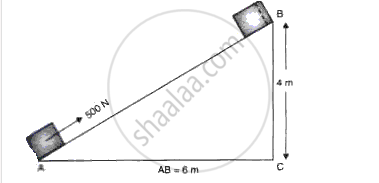Advertisements
Advertisements
प्रश्न
A block of mass 20 kg is pulled up a slope (fig.12) with a constant speed by applying a force of 500 N parallel to the slope. A and B are initial and final positions of the block.
(a) Calculate the work done by the force in moving the block from A and B.
(b) Calculate the potential energy gained by the block.

उत्तर
(a) given force = 500N
Vertical displacement = Final position - initial position = BC = 4m
work done = force x displacement = 500 x 4 = 2000J
(b) P.E gained = mgh = (mg) h = 500 x 4 = 2000J
APPEARS IN
संबंधित प्रश्न
Define 1 J of work.
What is the work done by the moon when it revolves around the earth?
The power of a motor is 40 kW. At what speed can the motor raise a load of 20,000 N?
A car is running at a speed of 15 km h-1 while another similar car is moving at a speed of 45 km h-1. Find the ratio of their kinetic energies.
State two advantage of producing hydroelectricity.
State the law of conservation of energy.
How much work is done when a force of 1 N moves a body through a distance of 1 m in its own direction?
The work done on an object does not depend on the :
What is the SI unit of work?
Name the physical quantity associated with the 'rate of doing work'.
Give an example
Electrical energy changes to heat energy.
How is horse power related to the S. I. unit of power?
In the following case write yes, if the work is being done and no if no work is being done.
A coolie standing with a heavy load on his head
In what way does an ‘Ideal machine’ differ from a ‘Practical machine’?
The weights of two bodies are 2.0 N and 2.0 kgf respectively what is the mass of each body?
